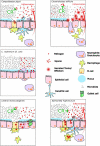Mouse models for bacterial enteropathogen infections: insights into the role of colonization resistance
- PMID: 36794831
- PMCID: PMC9980611
- DOI: 10.1080/19490976.2023.2172667
Mouse models for bacterial enteropathogen infections: insights into the role of colonization resistance
Abstract
Globally, enteropathogenic bacteria are a major cause of morbidity and mortality.1-3 Campylobacter, Salmonella, Shiga-toxin-producing Escherichia coli, and Listeria are among the top five most commonly reported zoonotic pathogens in the European Union.4 However, not all individuals naturally exposed to enteropathogens go on to develop disease. This protection is attributable to colonization resistance (CR) conferred by the gut microbiota, as well as an array of physical, chemical, and immunological barriers that limit infection. Despite their importance for human health, a detailed understanding of gastrointestinal barriers to infection is lacking, and further research is required to investigate the mechanisms that underpin inter-individual differences in resistance to gastrointestinal infection. Here, we discuss the current mouse models available to study infections by non-typhoidal Salmonella strains, Citrobacter rodentium (as a model for enteropathogenic and enterohemorrhagic E. coli), Listeria monocytogenes, and Campylobacter jejuni. Clostridioides difficile is included as another important cause of enteric disease in which resistance is dependent upon CR. We outline which parameters of human infection are recapitulated in these mouse models, including the impact of CR, disease pathology, disease progression, and mucosal immune response. This will showcase common virulence strategies, highlight mechanistic differences, and help researchers from microbiology, infectiology, microbiome research, and mucosal immunology to select the optimal mouse model.
Conflict of interest statement
No potential conflict of interest was reported by the author(s).
Figures


Similar articles
-
Comparing Campylobacter jejuni to three other enteric pathogens in OligoMM12 mice reveals pathogen-specific host and microbiota responses.Gut Microbes. 2025 Dec;17(1):2447832. doi: 10.1080/19490976.2024.2447832. Epub 2025 Jan 21. Gut Microbes. 2025. PMID: 39835346
-
Possible link between colonization of the gastrointestinal tract by Citrobacter rodentium in C57BL/6 mice and microbiota composition.Microbiol Immunol. 2024 Jun;68(6):206-211. doi: 10.1111/1348-0421.13128. Epub 2024 Apr 21. Microbiol Immunol. 2024. PMID: 38644589
-
Gut Microbiota and Colonization Resistance against Bacterial Enteric Infection.Microbiol Mol Biol Rev. 2019 Jun 5;83(3):e00007-19. doi: 10.1128/MMBR.00007-19. Print 2019 Aug 21. Microbiol Mol Biol Rev. 2019. PMID: 31167904 Free PMC article. Review.
-
Overview of the Effect of Citrobacter rodentium Infection on Host Metabolism and the Microbiota.Methods Mol Biol. 2021;2291:399-418. doi: 10.1007/978-1-0716-1339-9_20. Methods Mol Biol. 2021. PMID: 33704766 Review.
-
Citrobacter rodentium: a model enteropathogen for understanding the interplay of innate and adaptive components of type 3 immunity.Mucosal Immunol. 2017 Sep;10(5):1108-1117. doi: 10.1038/mi.2017.47. Epub 2017 Jun 14. Mucosal Immunol. 2017. PMID: 28612839 Free PMC article. Review.
Cited by
-
Immunostimulating Commensal Bacteria and Their Potential Use as Therapeutics.Int J Mol Sci. 2023 Oct 27;24(21):15644. doi: 10.3390/ijms242115644. Int J Mol Sci. 2023. PMID: 37958628 Free PMC article. Review.
-
Oral treatment of human gut microbiota associated IL-10-/- mice suffering from acute campylobacteriosis with carvacrol, deferoxamine, deoxycholic acid, and 2-fucosyl-lactose.Front Microbiol. 2024 Jan 25;15:1290490. doi: 10.3389/fmicb.2024.1290490. eCollection 2024. Front Microbiol. 2024. PMID: 38343716 Free PMC article.
-
Context-dependent change in the fitness effect of (in)organic phosphate antiporter glpT during Salmonella Typhimurium infection.Nat Commun. 2025 Feb 24;16(1):1912. doi: 10.1038/s41467-025-56851-5. Nat Commun. 2025. PMID: 39994176 Free PMC article.
-
The microbiota conditions a gut milieu that selects for wild-type Salmonella Typhimurium virulence.PLoS Biol. 2023 Aug 31;21(8):e3002253. doi: 10.1371/journal.pbio.3002253. eCollection 2023 Aug. PLoS Biol. 2023. PMID: 37651408 Free PMC article.
-
Salmonella Type III Secretion Effector SrfJ: A Glucosylceramidase Affecting the Lipidome and the Transcriptome of Mammalian Host Cells.Int J Mol Sci. 2023 May 7;24(9):8403. doi: 10.3390/ijms24098403. Int J Mol Sci. 2023. PMID: 37176110 Free PMC article.
References
-
- The burden of foodborne diseases in the WHO European Region . (WHO Regional Office for Europe, Copenhagen, Denmark, 2017).
-
- CDC . Antibiotic resistance threats in the United States, 2019. (2019).
-
- Organization, W. H . World health statistics 2021: monitoring health for the SDGs, sustainable development goals. (WHO, 2021).
Publication types
MeSH terms
LinkOut - more resources
Full Text Sources
Molecular Biology Databases
